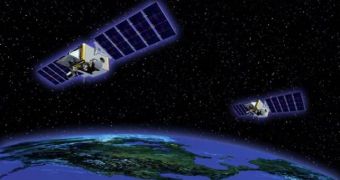The US government defense system contractor Northrop Grumman has recently announced that the second Space Tracking and Surveillance System (STSS) satellite is completed and awaiting orders from the Missile Defense Agency (MDA), as to its launch date. The classified military satellite will most likely join the first one, already completed, at a payload processing facility near Cape Canaveral Air Force Station (CCAFS), in Florida.
Though they were scheduled for lift off in August, most likely that launch date will not be respected, because of the delays that the space shuttle Endeavor's hydrogen fuel tank leaks caused in NASA's launch manifest for this year. The CCAFS just hosted a very important launch on June 18th, when the Lunar Reconnaissance Orbiter and the Lunar Crater Observation and Sensing Satellite (LRO/LCROSS) mission launched for the Moon.
It will be some time before the pads are ready for another lift-off, but Endeavor is scheduled to launch to the International Space Station (ISS) on its STS-127 assembly mission on July 11th. However, the faith of the shuttle is not certain, as in engineers don't know if the glitch was properly fixed or not. Under these conditions, NASA cannot afford to make plans for other launches, before this situation is resolved. The two STSS satellites are scheduled to be launched in a stacked configuration aboard a United Launch Alliance Delta 2 rocket, Space informs.
“I am concerned with lapses in quality management involving several of our industry partners that have impacted system element cost, schedule and performance. There have been frequent schedule slips on the STSS program, some resulting in significant delays, due to quality issues caused by lack of discipline and detail in the procedures,” Army Lt. Gen. Patrick O'Reilly, who is the director of the MDA, said of the construction process. The agency had a $152-million budget overrun in 2008, he added for a House Armed Services subcommittee in a testimony on May 21st.
Air Force Col. Jay Morgan, who is the STSS program director at the MDA, explained that these types of problems could not be averted when a technology was being built for the first time. “Those problems are largely behind us. We had successful acoustic testing in August in the stacked configuration, so we've aggressively worked those issues and are moving toward a launch this year. It would be difficult for me to go down that list of items. When these are on orbit, our projections are that all technical parameters will be satisfied,” the STSS Program Manager at Northrop Grumman, Gabe Watson, pinpointed.
“Even though the hardware was built in the 1990s, when the two STSS demonstrators are on orbit, they will bring a unique capability to the MDA. We can track missiles in every stage of flight, from launch to intercept, and do hit assessment as well. If the MDA wants to intercept missiles in the ascent phase, they will need additional data that [existing missile warning platforms] don't provide,” Watson concluded by saying.

 14 DAY TRIAL //
14 DAY TRIAL //